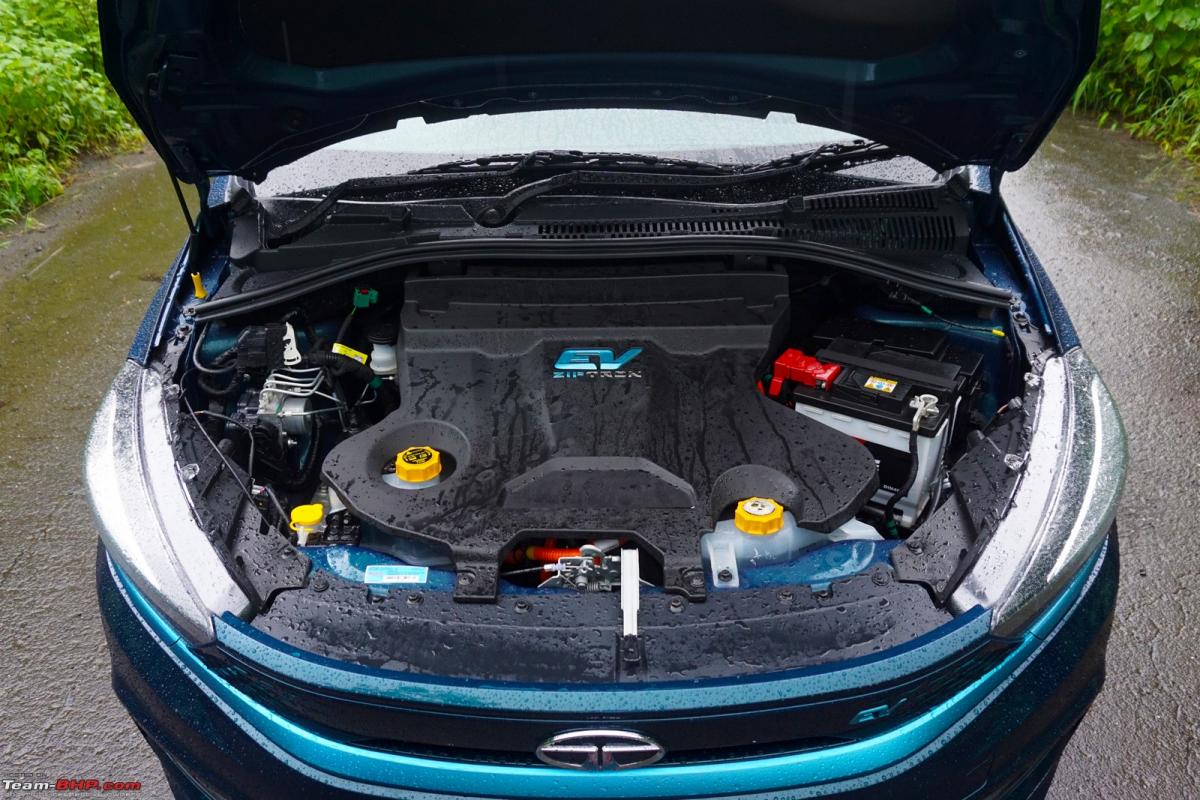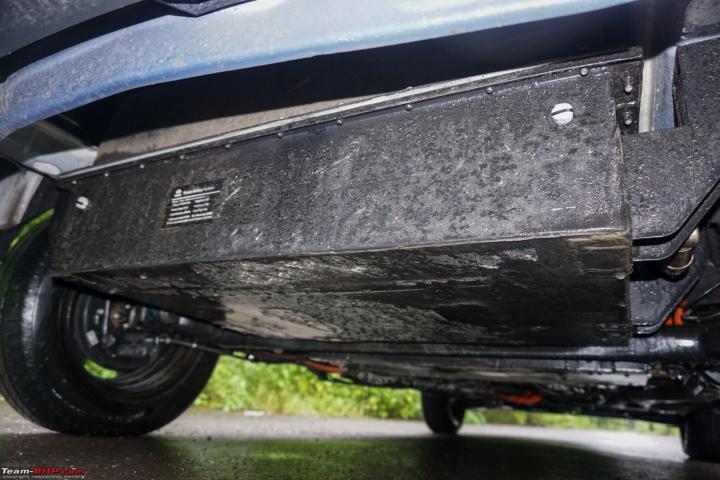News
Tata Tigor Electric: Our observations after 2 days of driving
Think of "D" being more like "ECO" mode. Performance in D mode is decent, but that's it. You won’t have any issues keeping up with city traffic & power is sufficient for day-to-day commuting.
Driving the Tata Tigor EV
Permanent Magnet Synchronous Motor puts out 74 BHP & 170 Nm of torque. That's far lower than the Nexon EV's 127 BHP & 245 Nm:

Before we get to the driving part, let’s get some basics right. There are 3 main components in an EV – the battery, the motor and the controller/charger. The battery is what stores the energy and the motor is what uses that energy to move the car. The controller/charger converts the energy from the battery into a usable form to power the motor. In more technical terms, the power grid from your house or a charging station is usually an AC current. The lithium-ion battery can store electric energy in DC form. So while charging, there’s usually an AC/DC converter that will convert the power grid's AC into DC and store it in your car’s battery. The DC fast chargers that you see usually have the AC/DC converter inbuilt, which is how they can charge your car’s battery faster. The controller typically sits on top of the motor. In the case of the Tigor EV, the controller and motor are placed under the bonnet.
Now, let’s get to the driving part. Most of us are still getting used to the eerie silence of EVs after pressing the start/stop button. But it takes just a couple of drives to feel comfortable with it. "Start" the car and its digital speedometer goes all the way up to 160 km/h, then dropping back to 0. There are 4 transmission modes to choose from – D, R, N and S. ‘D’ mode is more designed for city driving conditions, while ‘S’ mode is when you want that extra power (at the cost of FE, which in this case is the battery charge level). We sure wish there was a "P" (park) mode like the Hyundai Kona & MG ZS EV which would lock the wheels in place. Right now, your only option is "N" with the handbrake. Tata should fix this in its future EVs.
As a safety feature, the car will always start in "N" mode. Engage D, take your foot off the brake pedal and the Tigor EV gets off the line in a perfectly smooth manner, crawling at 6 km/h. It’s very linear and without any jerks. With 170 Nm of torque available from 0 rpm, Tata claims that the Tigor EV has a maximum restart gradeability of 29-degrees. Meaning, the car can crawl forward from a standstill on an incline of up to 29 degrees with ease.
Driving around in "D" mode within the city is a super convenient affair. No clutch, no gears, no turbo lag & no noise means even a newbie driver will seem like a smooth driver. The motor has sufficient torque, but it is used conservatively in "D" mode for a smoother driving experience & to maximise driving range. Think of "D" being more like "ECO" mode. Performance in D mode is decent, but that's it. You won’t have any issues keeping up with city traffic & power is sufficient for day-to-day commuting. When you want to suddenly accelerate from say 40 - 50 km/h though, you will feel the power deficit & it feels like a 1.2L NA petrol! If you want quicker acceleration, simply switch to "S" mode and you’ll notice a BIG difference in the way the power is put down. Throttle response is much sharper and you get a stronger surge of power. Added bonus = in "S", you'll see the power gauge on the left showing a redline at the limit (via 3 red bars), just like a conventional rev counter.
Out on the open road, D mode is adequate for regular drivers. You can cruise comfortably on the expressway. However, if you need to execute an overtaking manoeuvre quickly, S mode comes in handy. You'll also find yourself engaging "S" mode whenever you are in the mood for some fun. The Tigor EV feels peppy in Sport mode, even on the open road. Power is delivered strongly till 100 km/h, after which it starts to taper off. The Tigor EV's top speed is limited to an indicated 122 km/h (GPS showed 116 km/h) and progress from 110 - 120 km/h is quite slow. Must add that electric cars aren't good at high-speed cruising, from the range point-of-view. Drive continuously at 110 - 120 km/h in "S" mode and you'll see the battery level drop alarmingly fast. That's one of the reasons you'll see most EVs driving at 80 - 90 km/h on the expressway in the middle lane.
Regenerative Braking
Unlike some other EVs like the Hyundai Kona or MG ZS EV, you cannot adjust the level of regenerative braking in the Tigor EV. That sucks as we'd like the option to select, depending on the driving condition or individual preferences. There’s just one standard level of regenerative braking and it is quite mild compared to other EVs. Tata says they have kept it mild based on feedback from Nexon owners and for a smoother drive experience. Can’t argue with that; regen does take getting used to, especially if it's aggressive. Tata has provided a regen meter on the instrument cluster with 6 bars to show you how much energy you are regenerating. The maximum regeneration that we saw under heavy braking is 4 bars worth.
Again, we really wish Tata gave adjustable regen levels in the Tigor EV, as enthusiasts who like engine-braking in ICE cars usually prefer the higher regen settings. On the highest setting, you can also do one-pedal driving in many situations. Plus, aggressive regen can be used to maximise range.
Noise, Vibration & Harshness (NVH)
Well, there’s no engine noise for starters! The only sound coming is a faint whirring by the electric motor. No gearshifts & minimal mechanical parts mean no jerks or vibrations. On the highway, tyre noise starts creeping into the cabin early at 80 km/h. You'll hear it more because there is no engine sound to drown some of it out.
Range
Range anxiety is a big concern with EVs. However, it’s only when you are pushing the car hard that you'll notice the range and battery percentage falling at a rapid pace. The ARAI-certified range for the Tigor EV under standard test conditions is 306 km, but under normal driving conditions, you can expect a range of ~200 km. 200 km is enough for those intending to drive primarily in the city.
Charging
Tata Motors has been working with its sister company, Tata Power, to improve the charging infrastructure levels. There were about 60 Tata charging stations in January 2020. The number has grown to 640 this August.
That said, we can tell you that the best place to charge your EV is at home. Cheapest + most convenient. At an average cost of Rs. 8 per unit, you’ll be paying Rs. 208 for a full tank at home.
The Tigor EV gets a CCS Type 2 charging port, which is currently the standard for electric vehicles in India. The estimated charging time from 0-80% from a 15A plug point is about 8 hours & 45 minutes. A 25 kW DC fast charger can charge the batteries to 80% in 65 minutes. For a DC fast charger, you will have to pay ~Rs. 18-20 per unit. So a full tank would be Rs. 520 in just over an hour.
Suspension

Ride Comfort
The Tigor EV gets a MacPherson strut suspension at the front and a twist-beam dual-path strut suspension at the rear. It rides on 14-inch rims shod with 175/65 section tyres. The recommended tyre pressure rating is 33 PSI at the front and 38 PSI at the rear. This makes sense as the battery pack has been placed directly above the rear suspension.
Like most fossil fuel cars converted to electric, the Tigor EV's suspension has been stiffened up due to the heavy battery pack it is carrying. You'll notice the firmer suspension as soon as you start driving the car. Over some mildly uneven roads in the city at slow speeds, there is a fair bit of movement in the cabin and it even feels jiggly at times. You feel more of the road in the Tigor EV, but still, ride quality is liveable & compliant enough on most city roads. It's only the really big bumps that come in strong, as do the sharp road dips. On the other hand, the Tigor EV rides rather flat on the expressway.
Handling & Dynamics
There are a couple of things that aid the handling characteristics of the Tigor EV. Firstly, it’s the firmer suspension and secondly, the heavy mechanicals (battery pack + motor) that lower the centre of gravity. High-speed stability is very good and you’ll be doing 110 - 120 km/h on the expressway without feeling nervous at all.
Get on some twisty roads and you’ll appreciate the stiffer suspension. The car feels agile and you can carry good speed into corners. The suspension setup does complement the chassis well and the Tigor EV holds its line nicely by family sedan standards. Changing direction on back-to-back corners is no problem either. Earlier, I had apprehensions that the heavy battery pack at the rear might cause some imbalance, but we didn't face any problem on our (admittedly) limited test drive. The only issue is the 175/65 section rubber which is meant for maximizing range and not for pushing hard into corners. On a particularly wet day outside Mumbai, the only factors keeping us from driving the car aggressively on curvy roads were the tyres and the alarmingly fast depletion of the battery charge! Yes, the battery level drops rapidly if you drive like a BHPian.
Steering
The electric power-assisted steering is a nice unit and is super light at parking speeds. The turning radius of 5.1m is user-friendly and you can manoeuvre the car easily with gentle inputs on the steering. It weighs up adequately as you gain speed. However, the EPS is dead and there’s not much feel or feedback from it.
Braking
The Tigor EV gets disc brakes at the front and drum brakes at the rear. Their performance, in general, is satisfactory. However, we feel that wider tyres would definitely improve the braking performance of the car. Another sore point is that, like most EVs, the brake pedal has a spongy & rubbery feel. It feels weird at first.
Continue reading the discussion on the 2021 Tata Tigor Electric on our forum.
























